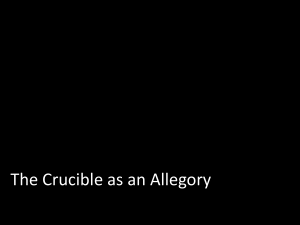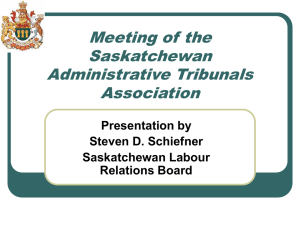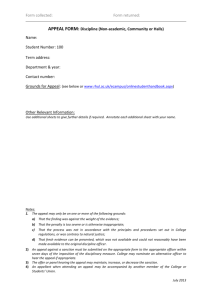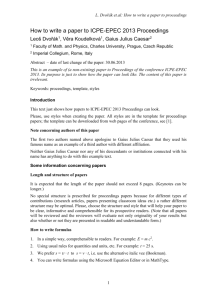Oppositions Appeals and Oral Proceedings at the EPO (Michael
advertisement
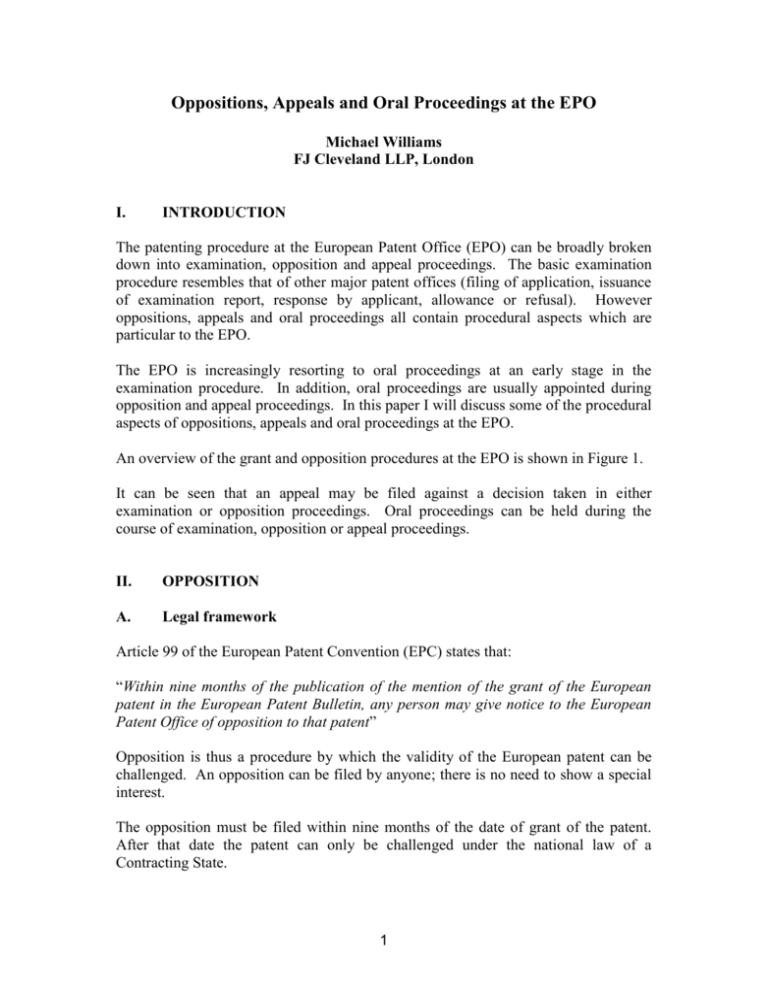
Oppositions, Appeals and Oral Proceedings at the EPO Michael Williams FJ Cleveland LLP, London I. INTRODUCTION The patenting procedure at the European Patent Office (EPO) can be broadly broken down into examination, opposition and appeal proceedings. The basic examination procedure resembles that of other major patent offices (filing of application, issuance of examination report, response by applicant, allowance or refusal). However oppositions, appeals and oral proceedings all contain procedural aspects which are particular to the EPO. The EPO is increasingly resorting to oral proceedings at an early stage in the examination procedure. In addition, oral proceedings are usually appointed during opposition and appeal proceedings. In this paper I will discuss some of the procedural aspects of oppositions, appeals and oral proceedings at the EPO. An overview of the grant and opposition procedures at the EPO is shown in Figure 1. It can be seen that an appeal may be filed against a decision taken in either examination or opposition proceedings. Oral proceedings can be held during the course of examination, opposition or appeal proceedings. II. OPPOSITION A. Legal framework Article 99 of the European Patent Convention (EPC) states that: “Within nine months of the publication of the mention of the grant of the European patent in the European Patent Bulletin, any person may give notice to the European Patent Office of opposition to that patent” Opposition is thus a procedure by which the validity of the European patent can be challenged. An opposition can be filed by anyone; there is no need to show a special interest. The opposition must be filed within nine months of the date of grant of the patent. After that date the patent can only be challenged under the national law of a Contracting State. 1 Following the decisions G 3/97 and G 4/97 of the Enlarged Board of Appeal, an opposition can also be filed by a so-called “Strawman”, that is, a person acting on behalf of a third party. As an exception to the general rule that an opposition can be filed by anyone, it is not possible for a patent proprietor to oppose his own patent (G 9/93). Previously this meant that there was no mechanism for a patent proprietor to amend a granted patent of his own volition at the EPO. However, the revised version of the European Patent Convention which came into force on 13 December 2007 (EPC 2000) introduced a new central limitation procedure which allows the patent proprietor to limit the claims in a granted patent centrally at the EPO, as discussed later. B. Nature of opposition proceedings While classical pre-grant opposition tends to be viewed as an extension of the administrative examination proceedings, post-grant opposition under the EPC has more in common with traditional revocation procedures. Thus, in G 9/91 it was stated that: “… it seems to the Enlarged Board in its present composition that post-grant opposition proceedings under the EPC are in principle to be considered as contentious proceedings between parties normally representing opposite interests, who should be given equally fair treatment.” Thus opposition is not viewed as a re-examination procedure, with the opposition division carrying out an investigative role. Rather, the role of the opposition division is to reach a decision based on the case put before it by the two parties. Nonetheless, in accordance with Rule 81 EPC, grounds for opposition not invoked by the opponent may be examined by the Opposition Division of its own motion if they would prejudice the maintenance of the European patent. In G 10/91 it was stated: “In principle, the Opposition Division shall examine only such grounds for opposition which have been properly submitted and substantiated… Exceptionally, the Opposition Division may … consider other grounds for opposition which, prima facie, in whole or in part would seem to prejudice the maintenance of the European patent.” An Opposition Division consists of three technically qualified examiners, at least two of whom have not take part in the examination proceedings (Article 19(2) EPC). The primary examiner is entrusted with the initial examination of the opposition (Guidelines D-II, 6.). Opposition proceeding are administrative proceedings of the EPO (see G 9/91). In contrast to the Boards of Appeal, the President of the EPO can issue instructions to Opposition Divisions. 2 C. Advantages of filing an opposition The opposition procedure provides several advantages to a potential opponent compared to revocation proceedings at the national offices or courts. A significant advantage is that the patent can be attacked centrally. Opposition proceedings are usually very cost effective compared to court proceedings. If opposition proceedings are pending, many national courts will stay any infringement proceedings until the opposition is decided. An opposition may be filed tactically, for example, to provide leverage in licensing negotiations. D. Grounds for Opposition According to Article 100 EPC, an opposition may only be filed on the grounds that: 1. the subject-matter of the European patent is not patentable within the terms of Article 52 to 57, because it - is not new, - does not involve an inventive step, - is not susceptible of industrial application, - is not regarded as an invention under Article 52, or - is excluded from patentability under Article 53; 2. the European patent does not disclose the invention in a manner sufficiently clear and complete for it to be carried out by a person skilled in the art; and 3. the subject-matter of the European patent extends beyond the content of the application as filed. Therefore some of the grounds on which a patent application may be refused during the examination procedure, such as lack of clarity, are not available as grounds of opposition. However, if amended claims are filed during opposition, then the amendments must be examined for clarity (T 301/87). E. Overview of opposition procedure An opposition must be filed within nine months of the date of grant of the patent (Article 99 EPC). The notice of opposition must include a statement of the grounds on which the opposition is based, and an indication of the facts, evidence and arguments presented in support of these grounds (Rule 76(c) EPC). The patent proprietor is given an opportunity to file his observations and to amend the patent (Rule 79(1) EPC). A period of four months, extendable to six months, is 3 usually set for the proprietor to respond (Guidelines D-IV, 5.2). Only amendments which are occasioned by a ground of opposition are allowed (Rule 80 EPC). If the proprietor responds to the notice of opposition by filing amendments to the patent, the opposition division invites the opponent to comment (Rule 79(3) EPC; Guidelines D-IV, 5.4). The opponent and the proprietor may file further submissions of their own volition, and these are communicated to the other party (Guidelines D-IV, 5.4). Since both parties normally file a conditional request for oral proceedings, the parties will normally be summoned to oral proceedings where a decision is taken. F. Timing of submissions According to Article 114 EPC, the EPO may disregard facts or evidence which are not submitted in due time. Therefore, in principle, an opponent is required to submit all of his objections and arguments during the nine month opposition period. However, late filed submissions may be admitted into the proceedings if, prima facie, there are clear reasons to suspect that such late-filed material would prejudice the maintenance of the patent in suit (T 1002/92). Thus an opponent is advised to file all submissions and evidence within the ninemonth opposition period if possible. If a relevant document comes to light later, it should be filed as soon as possible in order to increase the likelihood of it being admitted into the proceedings. If oral proceedings are to be held, the EPO will set a final date for both parties to make written submissions. New facts and arguments presented after that date need not be admitted (Rule 116(1) EPC). The patent proprietor may also be invited to file amendments to overcome any grounds of opposition, within the same deadline (Rule 116(2) EPC). At the discretion of the Opposition Division, any amendments filed after that date may be rejected. G. Intervention If an opposition has been filed, a third party who is being sued for infringement of the patent can intervene in the opposition proceedings (Article 105 EPC). This also applies if the third party has instituted proceedings for a declaration of noninfringement, following a request of the patent proprietor to cease alleged infringement. A notice of intervention must be filed within three months of the date on which the relevant proceedings are instituted (Rule 89(1) EPC). 4 H. Standard of Proof The standard of proof which is normally applied by the EPO is that of the overall balance of probability, or what is most likely (see T 270/90). However, the burden of proof lies with the person who is making the case. The inability to substantiate a matter goes against the person who relies on it (T 160/92). Thus, in opposition proceedings, the burden of proof is upon the opponent to establish that, on the balance of probability, grounds exist which prejudice maintenance of the patent (see T 182/89). However, in prior public use cases where practically all the evidence in support of an alleged prior public use lies within the power and knowledge of the opponent, the opponent has to prove his case “up to the hilt” (see T 472/92). III. CENTRAL LIMITATION PROCEDURE EPC 2000, which came into force on 13 December 2007, introduced a new central limitation and revocation procedure. Under the new procedure, a patent proprietor may apply to limit the scope of, or revoke, his patent. Article 105a(1) EPC: “At the request of the proprietor, the European patent may be revoked or be limited by an amendment of the claims...” There is no time limit for filing a request for limitation or revocation. However, the request may not be filed while opposition proceedings in respect of the European patent are pending (Article 105a(2) and Rule 93(1) EPC). Decisions on requests for limitation or revocation are taken by the Examining Division (Rule 91 EPC). The request for limitation or revocation is first checked for compliance with formalities (Rule 92 EPC). If a request for revocation is admissible, the patent is revoked (Rule 95(1) EPC). If a request for limitation is admissible, the Examining Division examines whether the amended claims constitute a limitation vis-à-vis the claims as granted or amended in opposition or limitation proceedings. The claims are also checked for clarity (Article 84 EPC), and to ensure that they do not add subject matter (Article 123(2) EPC) or extend the scope of protection (Article 123(3) EPC). However, no check is made for compliance with other requirements of the EPC such as novelty or inventive step. 5 If a request for limitation is allowable, the Examining Division limits the patent (Rule 95(3) EPC). The central limitation procedure may provide a convenient way for a patent proprietor to limit his patent centrally, for example, to distinguish over new prior art. In accordance with Rule 93 EPC, opposition proceedings take precedence over limitation and revocation proceedings. Thus, if an opposition is filed while limitation proceedings are pending, the Examining Division terminates the limitation proceedings. IV. APPEALS A. Legal framework Appeal is a procedure by which someone adversely affected by a decision of the EPO may challenge that decision. Article 106 EPC states that: “(1) An appeal shall lie from decisions of the Receiving Section, Examining Divisions, Opposition Divisions and the Legal Division. It shall have suspensive effect. (2) A decision which does not terminate proceedings as regards one of the parties can only be appealed together with the final decision, unless the decision allows a separate appeal…” Thus appeals are only open against decisions, not against communications (see T 934/91). Article 107 EPC states that: “Any party to proceedings adversely affected by a decision may appeal. Any other parties to the proceedings shall be parties to the appeal proceedings as of right.” As a consequence, parties in the first instance who did not file an appeal are allowed to participate in the appeal proceedings. However, a non-appealing party cannot pursue a request which is more extensive than the first instance decision. Thus, in principle, a sole appellant can not be put in a worse position than if he had not appealed (see G 1/99). B Nature of Appeal proceedings The appeal procedure is that of an administrative court. This was confirmed in the Enlarged Board of Appeal decisions G 8/91 and G 9/91. 6 In G 8/91 it was stated that: “Whereas the opposition procedure is a purely administrative procedure, the appeal procedure must be regarded as a procedure proper to an administrative court…”, and in G 9/91 it was stated that: “… in contrast to the merely administrative character of the opposition procedure, the appeal procedure is to be considered as a judicial procedure… Such procedure is by its very nature less investigative than an administrative procedure.” Appeals are heard by the Boards of Appeal. For an appeal from a decision of an Examining Division or an Opposition Division, a Board of Appeal normally consists of two technically qualified members and one legally qualified member (Article 21 EPC). One of the members of the Board is designated as rapporteur, and is responsible for the initial examination of the Appeal (Article 5, Rules of Procedure of the Boards of Appeal). The independence of the members of the Boards is enshrined in Article 23 EPC. Article 23(2) states: “In their decisions the members of the Boards shall not be bound by any instructions and shall comply only with the provisions of this Convention.” Thus, contrast to Examination Divisions and Opposition Divisions, the President of the EPO cannot issue instructions to members of the Boards of Appeal. C. Appeal procedure The time limit for filing a notice of appeal is two months from the date of the decision (Article 108 EPC). The notice of appeal must contain the name and address of the appellant, an indication of the decision impugned, and a request defining the subject of the appeal (Rule 99 EPC). Notice of appeal is not deemed to have been filed until the appeal fee has been paid. A statement setting out the grounds of appeal must be filed within four months of the date of the decision (Article 108 EPC). The statement of grounds of appeal must substantiate the grounds of appeal; reference to arguments filed in the first instance proceedings is not enough. Thus, according to T 220/83: “Grounds for appeal may not be confined to an assertion that the contested decision is incorrect but should state the legal or factual reasons why the decision should be set aside.” 7 A notice of appeal is first checked for compliance with formalities. Once an admissible appeal has been filed, the procedure is dictated by the Board of Appeal. According to Rule 100(2) EPC: “In the examination of the appeal, the Board of Appeal shall invite the parties, as often as necessary, to file observations, within a period to be specified, on communications issued by itself or observations submitted by another party.” Oral proceedings are appointed if deemed expedient or at the request of any party to the proceedings (Article 116 EPC). If oral proceedings are appointed, the decision is usually taken at the conclusion of the oral proceedings (Article 14, Rules of Procedure of the Boards of Appeal). In issuing a decision, the Board of Appeal may either exercise any power within the competence of the department which was responsible for the decision appealed, or remit the case to that department for further prosecution (Article 111(2) EPC). D. Decision or Opinion of Enlarged Board of Appeal The Enlarged Board of Appeal issues decisions or opinions on points of law. Article 112 EPC states: “(1) In order to ensure uniform application of the law, or if a point of law of fundamental importance arises: (a) the Board of Appeal shall, during proceedings on a case and either of its own motion or following a request from a party to the appeal, refer any question to the Enlarged Board of Appeal if it considers that a decision is required for the above purposes… (b) the President of the European Patent Office may refer a point of law to the Enlarged Board of Appeal where two Boards of Appeal have given different decisions on that question.” Thus referral to the Enlarged Board is either from a Board of Appeal or the President of the EPO. Where a referral is from a Board of Appeal, the Enlarged Board’s decision is binding on the Board of Appeal making the request (Article 112(3) EPC). E. Petition for review by the Enlarged Board Prior to the introduction of EPC 2000, it was decided in the decision of the Enlarged Board of Appeal G 1/97 that a request for revision of a decision of a Board of Appeal 8 must be refused, even in the case of an alleged violation of a fundamental procedural principle. This situation was regarded by some as potentially inequitable. EPC 2000 introduced a new procedure for a limited review of Board of Appeal decisions where a fundamental procedural violation or criminal act is alleged to have occurred. Article 112a(1) EPC states: “Any party to appeal proceedings adversely affected by the decision of the Board of Appeal may file a petition for review of the decision by the Enlarged Board of Appeal.” The petition for review may only be filed on the grounds that: (a) a member of the Board of Appeal had a conflict of interest (in breach of Article 24 EPC); (b) the Board of Appeal included a person not appointed as a member of the Boards of Appeal; (c) a fundamental violation of the right to be heard occurred (in breach of Article 113 EPC); (d) any other fundamental procedural defect defined in the Implementing Regulations occurred in the appeal proceedings; or (e) a criminal act may have had an impact on the decision. A petition under grounds (a) to (d) above is only admissible where an objection in respect of the procedural defect was raised during the appeal proceedings and dismissed by the Board of Appeal, except where such objection could not be raised during the appeal proceedings (Rule 106 EPC). The Enlarged Board of Appeal consisting of two legally qualified members and one technically qualified member examines all petitions for review. Those which are clearly inadmissible or unallowable are rejected. Any petition not so rejected is considered by four legally qualified members and one technically qualified member (Rule 109 EPC). If the Enlarged Board allows the petition, the decision of the Board of Appeal is set aside and the proceedings are re-opened, if necessary with members of the Board of Appeal who took part in the decision being replaced (Rule 108 EPC). Since the introduction of EPC 2000 a large number of petitions for review have been filed. The majority have been dismissed as inadmissible or unallowable. However, in the decision R 7/09 the petition for review was allowed because the statement setting out the grounds of appeal was never notified to the respondent/patent proprietor. 9 V. ORAL PROCEEDINGS A. Background Oral proceedings are proceedings in which the party or parties may present their case orally. In contrast to interviews, each party has a procedural right to oral proceedings. Article 116 EPC states “Oral proceedings shall take place either at the instance of the European Patent Office if it considers this to be expedient or at the request of any party to the proceedings.” Thus, if oral proceedings are requested, a decision cannot be taken until oral proceedings have been held. The oral proceedings will usually be used to settle as far as possible all outstanding issues, in order to allow a decision to be taken (see Guidelines, E-III, 5.) Oral proceedings are often conditionally requested when filing a response to an examination report, so that the application cannot be directly refused. As a consequence of this tactic by applicants, Examining Divisions of the EPO are increasingly resorting to oral proceedings at a relatively early stage in the proceedings, in order to dispose of the case more quickly. B. Overview of procedure If oral proceedings are to be held, a date for the hearing is set by relevant division or board (Rule 115 EPC). The oral proceedings are usually heard at the EPO site where the division or board is based (Munich, the Hague, or Berlin). At the same time a final date for making written submissions in preparation for the oral proceedings is fixed (Rule 116 EPC). This is usually one month before the hearing (Guidelines D-VI, 3.2 and E-III, 5.). A decision is usually taken at the conclusion of the oral proceedings. The decision is subsequently put in writing and notified to the parties (Rule 111 EPC). C. Auxiliary requests In advance of the oral proceedings, the applicant or proprietor may file one set of claims as a main request, and one or more alternative sets of claims as auxiliary requests (see Legal Advice from the European Patent Office No. 15/98, OJ EPO 3/1998, 113). During the oral proceedings, the main request will be examined first, followed by the auxiliary requests, until a request is found to be allowable, or all requests have been refused. 10 It is therefore usually advisable for the applicant or proprietor to file one or more auxiliary requests, in order to avoid abandoning his preferred position, while keeping open one or more fallback positions in case the main request fails. Normally the most broadly worded claims will be filed as a main request, and successively limited versions as auxiliary requests. The applicant or proprietor can ask for an appealable decision on the main request or an auxiliary request, even if a subsequent auxiliary request is found to be allowable. This can allow the applicant or proprietor to decide at a later date whether to appeal the decision, or accept the allowable claims. D. Oral proceedings during examination If oral proceedings are held during the examination procedure, the case is heard by the Examining Division, which usually consists of three technically qualified examiners (Article 18 EPC). The Chairman of the Division conducts the proceedings (Guidelines E-III, 8.2). Oral proceedings during the examination procedure are not public (Article 116(3) EPC). Thus, a third party who might be interested in the case is not able to attend, and has no right to make any oral submissions. As the examination procedure is an administrative procedure, and the oral proceedings are ex parte, the hearing can be fairly informal. The applicant usually presents his case, and the Examining Division then takes its decision. E. Oral proceedings during opposition Oral proceedings are usually held as part of the opposition procedure, since in most cases both parties file a conditional request for oral proceedings. If oral proceedings are appointed, the case is heard by the Opposition Division, which usually consists of three technically qualified examiners (Article 19 EPC). The Chairman of the Division conducts the proceedings (Guidelines E-III, 8.2). Since opposition proceedings are in principle considered as contentious proceedings between the parties, the oral proceedings are adversarial in nature with the Opposition Division deciding on the merits of the cases put before it (see G 9/91). Nonetheless, grounds for opposition not invoked by the opponent may be examined by the Opposition Division of its own motion if they would prejudice the maintenance of the European patent (Rule 81 EPC). Oral proceedings before the Opposition Division are held in public (Article 116(4) EPC). They are more formal than oral proceedings during examination, due to the need for the Opposition Division to treat each side equally. 11 Oral proceedings are usually held in the language of the proceedings, that is, the official language in which the application was filed or translated into (Article 14(3) EPC). However, any party to the oral proceedings may use another official language of the EPO, and the EPO will provide interpretation if sufficient notice is given (Rule 4 EPC). The normal course of oral proceedings before the Opposition Division is as follows (Guidelines E-III, 8.): The Chairman opens the proceedings and introduces the parties present The Chairman outlines the stage reached in the proceedings The opponent is allowed the floor to put his case The patent proprietor is allowed the floor to put his response A discussion is conducted concerning any technical or legal questions which are relevant to the decision Both sides are given the opportunity of making a final reply The Opposition Division deliberates on the matter in the absence of the parties The Chairman gives the decision of the Division Where there are several alleged grounds of opposition, each ground may be treated separately. Where one or more auxiliary requests are filed, these are usually considered in turn. E. Oral proceedings during appeal procedure Oral proceedings during the appeal procedure are heard by the Board of Appeal. They tend to be formal, in keeping with the judicial nature of the appeal procedure. In an appeal from a decision of the Opposition Division, the normal course of the proceedings is the same as that during the opposition procedure. A final decision may be taken, or the case may be remitted to the department of first instance for a decision. 12 Figure 1 Grant procedure FILE APPLICATION SEARCH AND EXAMINATION ORAL PROCEEDINGS N GRANT? APPEAL PROCEDURE Y ORAL PROCEEDINGS APPEAL ALLOWED? Y N PATENT GRANTED REFUSAL NATIONAL LAW Opposition procedure PATENT GRANTED N OPPOSITION FILED? Y LIMITATION PROCEDURE OPPOSITION PROCEDURE ORAL PROCEEDINGS NATIONAL LAW APPEAL PROCEDURE ORAL PROCEEDINGS PATENT MAINTAINED PATENT REVOKED NATIONAL LAW 13



